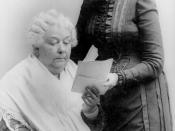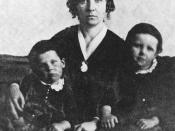"It is hot, muggy, nasty, and the battle is desperate," wrote Elizabeth Cady Stanton in the Tennessee courthouse, August 19, 1920. Stanton was referring to the vote on the Nineteenth Amendment. After the Senate and House of Representatives passed the bill, thirty-six states would have to ratify it. Tennessee had to be the thirty-sixth. There was no other option. Either the amendment was ratified by Tennessee, and added to the Constitution as the Nineteenth Amendment, or all hope would die. By March 22nd, 1920, thirty-five states had ratified, Wisconsin, Illinois, and Michigan being the first and Washington being the thirty-fifth. This left one out of the remaining thirteen states who had to ratify. However, Virginia, Massachusetts, Louisiana, Delaware, South Carolina, Alabama, Georgia, and Mississippi had all defeated the bill. This left five states, but it was getting close to summer recess and time was of the essence. Florida, Connecticut, Vermont, Tennessee, and North Carolina were left.
Florida went out of session before it could act. Time had run out for Connecticut and Vermont. They were out of session, and although suffragists urged to call a special session, both New England states refused.
This left North Carolina and Tennessee. Both would need to call special sessions. In March, 1920, the governor of North Carolina said he would call a session. He did not call a session for several months, but on August 10th the legislators convened. On August 13th, Governor Thomas W. Bickett said he ""æ doubted the wisdom and necessity of suffrage"æ," but he felt that ratification was unavoidable. He told his legislators to accept the inevitable and to ratify. Anti-suffrage feelings ran high and they ignored the governor's advice. This left only Tennessee, but there was a problem with this state, too. Under Tennessee's state constitution, Article...


